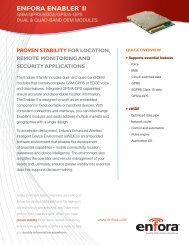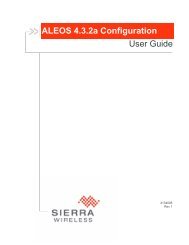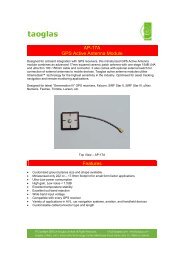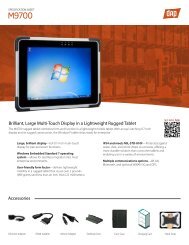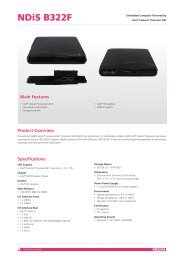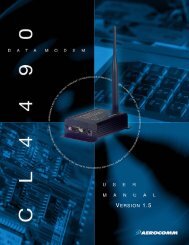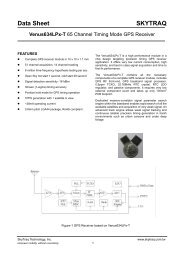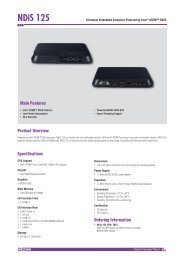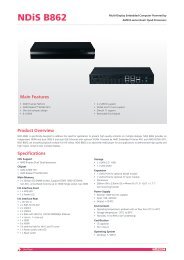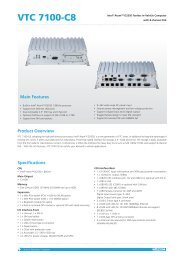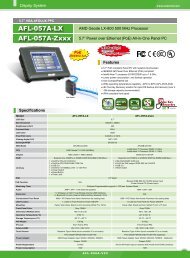Aerocomm AC4868.pdf - HEAnet Mirror Service
Aerocomm AC4868.pdf - HEAnet Mirror Service
Aerocomm AC4868.pdf - HEAnet Mirror Service
Create successful ePaper yourself
Turn your PDF publications into a flip-book with our unique Google optimized e-Paper software.
THEORY OF OPERATION 3<br />
RF ARCHITECTURE<br />
The AC4868-250 utilizes a Server-Client network where all Clients synchronize their hopping to the Server. The Server<br />
transmits a beacon during the first 1 ms of every hop (53 ms). The Client transceivers listen for this beacon and upon<br />
hearing it assert their In_Range Low and synchronize their hopping with the Server.<br />
Each network should consist of only one Server and there should never be two servers on the same RF Channel<br />
number in the same coverage area as the interference between the two servers will severely hinder RF<br />
communications.<br />
MODES OF OPERATION<br />
The AC4868-250 has three different operating modes; Receive, Transmit, & Command Mode. If the transceiver is not<br />
communicating with another radio, it will be in Receive Mode actively listening for a beacon from the Server. If the<br />
Client determines that the beacon is from a server operating on the same RF Channel and System ID, it will respond<br />
by asserting In_Range Low. A transceiver will enter Transmit or Command mode when the OEM Host sends data over<br />
the serial interface. The state of the Command/Data pin (Pin 17) or the data contents determine which of the two<br />
modes will be entered.<br />
Transmit Mode<br />
All packets sent over the RF are either Addressed or Broadcast packets. Broadcast and Addressed delivery can be<br />
controlled dynamically with the API Control byte and corresponding on-the-fly commands. To prohibit transceivers<br />
from receiving broadcast packets, Unicast only can be enabled.<br />
ADDRESSED PACKETS<br />
When sending an addressed packet, the RF packet is sent only to the receiver specified in destination address. To<br />
increase the odds of successful delivery, Transmit retries are utilized. transparent to the OEM Host; the sending radio<br />
will send the RF packet to the intended receiver. If the receiver receives the packet free of errors, it will return an RF<br />
acknowledge within the same 53 ms hop. If a receive acknowledgement is not received, the radio will use a transmit<br />
retry to resend the packet. The radio will continue sending the packet until either (1) an acknowledgement is received<br />
or (2) all transmit retries have been used. The received packet will only be sent to the OEM Host if and when it is<br />
received free of errors.<br />
BROADCAST PACKETS<br />
When sending a broadcast packet, the RF packet is sent out to every eligible transceiver on the network. To increase<br />
the odds of successful delivery, Broadcast attempts are utilized. Transparent to the OEM Host, the sending radio will<br />
send the RF packet to the intended receiver(s). Unlike transmit retries, all broadcast attempts are used; regardless of<br />
when the RF packet is actually received and without RF acknowledgements. If the packet is received on the first<br />
attempt, the receiver will ignore the remaining broadcast attempts. The received packet will only be sent to the OEM<br />
Host if and when it is received free of errors.<br />
Receive Mode<br />
When a transceiver is not in Transmit or Command mode, it will be in Receive Mode listening for data. While in<br />
Receive Mode, subsequent data of up to 80 bytes can be received every hop (53 ms).<br />
www.aerocomm.com



